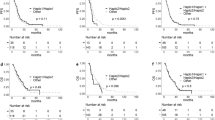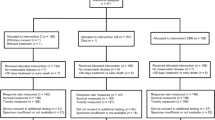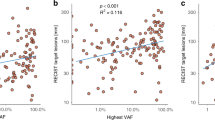Abstract
Recent studies suggest CD133, a surface protein widely used for isolation of colon cancer stem cells, to be associated with tumor angiogenesis and recurrence. We hypothesized that gene expression levels and germline variations in CD133 will predict clinical outcome in patients with metastatic colorectal cancer (mCRC), treated in first-line setting with 5-fluorouracil, oxaliplatin and bevacizumab (BV), and we investigated whether there is a correlation with gene expression levels of CD133, vascular endothelial growth factor (VEGF) and its receptors. We evaluated intra-tumoral gene expression levels by quantitative real-time (RT) PCR from 54 patients and three germline variants of the CD133 gene by PCR-restriction-fragment length polymorphism from 91 patients with genomic DNA. High gene expression levels of CD133 (>7.76) conferred a significantly greater tumor response (RR=86%) than patients with low expression levels (⩽7.76, RR=38%, adjusted P=0.003), independent of VEGF or its receptor gene expression levels. Gene expression levels of CD133 were significantly associated with VEGF and its receptors messenger RNA levels (VEGFR-1 (P<0.01), -2 and -3, P<0.05). Combined analyses of two polymorphisms showed a significant association with progression-free survival (PFS) (18.5 months vs 9.8 months, P=0.004) in a multivariate analysis as an independent prognostic factor for PFS (adjusted P=0.002). These results suggest that CD133 is a predictive marker for standard first-line BV-based treatment in mCRC.
This is a preview of subscription content, access via your institution
Access options
Subscribe to this journal
Receive 6 print issues and online access
$259.00 per year
only $43.17 per issue
Buy this article
- Purchase on Springer Link
- Instant access to full article PDF
Prices may be subject to local taxes which are calculated during checkout


Similar content being viewed by others
References
Ferrandina G, Petrillo M, Bonanno G, Scambia G . Targeting CD133 antigen in cancer. Expert Opin Ther Targets 2009; 13: 823–837.
Pohl A, Lurje G, Kahn M, Lenz HJ . Stem cells in colon cancer. Clin Colorectal Cancer 2008; 7: 92–98.
Al-Hajj M, Wicha MS, Benito-Hernandez A, Morrison SJ, Clarke MF . Prospective identification of tumorigenic breast cancer cells. Proc Natl Acad Sci USA 2003; 100: 3983–3988.
Collins AT, Berry PA, Hyde C, Stower MJ, Maitland NJ . Prospective identification of tumorigenic prostate cancer stem cells. Cancer Res 2005; 65: 10946–10951.
Ma S, Chan KW, Hu L, Lee TK, Wo JY, Ng IO et al. Identification and characterization of tumorigenic liver cancer stem/progenitor cells. Gastroenterology 2007; 132: 2542–2556.
O'Brien CA, Pollett A, Gallinger S, Dick JE . A human colon cancer cell capable of initiating tumour growth in immunodeficient mice. Nature 2007; 445: 106–110.
Ricci-Vitiani L, Lombardi DG, Pilozzi E, Biffoni M, Todaro M, Peschle C et al. Identification and expansion of human colon-cancer-initiating cells. Nature 2007; 445: 111–115.
Yu SC, Ping YF, Yi L, Zhou ZH, Chen JH, Yao XH et al. Isolation and characterization of cancer stem cells from a human glioblastoma cell line U87. Cancer Lett 2008; 265: 124–134.
Haraguchi N, Ohkuma M, Sakashita H, Matsuzaki S, Tanaka F, Mimori K et al. CD133+CD44+ population efficiently enriches colon cancer initiating cells. Ann Surg Oncol 2008; 15: 2927–2933.
Puglisi MA, Sgambato A, Saulnier N, Rafanelli F, Barba M, Boninsegna A et al. Isolation and characterization of CD133+ cell population within human primary and metastatic colon cancer. Eur Rev Med Pharmacol Sci 2009; 13 (Suppl 1): 55–62.
Zhu L, Gibson P, Currle DS, Tong Y, Richardson RJ, Bayazitov IT et al. Prominin 1 marks intestinal stem cells that are susceptible to neoplastic transformation. Nature 2009; 457: 603–607.
Shmelkov SV, Butler JM, Hooper AT, Hormigo A, Kushner J, Milde T et al. CD133 expression is not restricted to stem cells, and both CD133+ and CD133– metastatic colon cancer cells initiate tumors. J Clin Invest 2008; 118: 2111–2120.
Wang R, Chadalavada K, Wilshire J, Kowalik U, Hovinga KE, Geber A et al. Glioblastoma stem-like cells give rise to tumour endothelium. Nature 2010; 468: 829–833.
Elkhafif N, El Baz H, Hammam O, Hassan S, Salah F, Mansour W et al. CD133(+) human umbilical cord blood stem cells enhance angiogenesis in experimental chronic hepatic fibrosis. APMIS 2011; 119: 66–75.
Lord RV, Salonga D, Danenberg KD, Peters JH, DeMeester TR, Park JM et al. Telomerase reverse transcriptase expression is increased early in the Barrett's metaplasia, dysplasia, adenocarcinoma sequence. J Gastrointest Surg 2000; 4: 135–142.
Lurje G, Nagashima F, Zhang W, Yang D, Chang HM, Gordon MA et al. Polymorphisms in cyclooxygenase-2 and epidermal growth factor receptor are associated with progression-free survival independent of K-ras in metastatic colorectal cancer patients treated with single-agent cetuximab. Clin Cancer Res 2008; 14: 7884–7895.
Halpern J . Maximally selected X2 statistics for small samples. Biometrics 1982; 38: 1017–1023.
Siegmund R . Maximally selected X2 statistics. Biometrics 1982; 38: 1011–1016.
Leichman CG, Lenz HJ, Leichman L, Danenberg K, Baranda J, Groshen S et al. Quantitation of intratumoral thymidylate synthase expression predicts for disseminated colorectal cancer response and resistance to protracted-infusion fluorouracil and weekly leucovorin. J Clin Oncol 1997; 15: 3223–3229.
Schneider S, Park DJ, Yang D, El-Khoueiry A, Sherrod A, Groshen S et al. Gene expression in tumor-adjacent normal tissue is associated with recurrence in patients with rectal cancer treated with adjuvant chemoradiation. Pharmacogenet Genomics 2006; 16: 555–563.
Gonen M . Concordance probability and discriminatory power in proportional hazards regression. Biometrika 2005; 92: 965–970.
Berry G, Kitchin RM, Mock PA . A comparison of two simple hazard ratio estimators based on the log-rank test. Stat Med 1991; 10: 749–755.
Molinaro AM, Simon R, Pfeiffer RM . Prediction error estimation: a comparison of resampling methods. Bioinformatics 2005; 21: 3301–3307.
Carpenter J, Bithell J . Bootstrap confidence intervals: when, which, what? A practical guide for medical statisticians. Stat Med 2000; 19: 1141–1164.
Barcelos LS, Duplaa C, Kränkel N, Graiani G, Invernici G, Katare R et al. Human CD133+ progenitor cells promote the healing of diabetic ischemic ulcers by paracrine stimulation of angiogenesis and activation of Wnt signaling. Circ Res 2009; 104: 1095–1102.
Gehling UM, Ergün S, Schumacher U, Wagener C, Pantel K, Otte M et al. In vitro differentiation of endothelial cells from AC133-positive progenitor cells. Blood 2000; 95: 3106–3112.
Senegaglia AC, Brofman PR, Aita CA, Dallagiovanna B, Rebelatto CL, Hansen P et al. In vitro formation of capillary tubules from human umbilical cord blood cells with perspectives for therapeutic application. Rev Bras Cir Cardiovasc 2008; 23: 467–473.
Folkman J . Angiogenesis in cancer, vascular, rheumatoid and other disease. Nat Med 1995; 1: 27–31.
Willett CG, Boucher Y, di Tomaso E, Duda DG, Munn LL, Tong RT et al. Direct evidence that the VEGF-specific antibody bevacizumab has antivascular effects in human rectal cancer. Nat Med 2004; 10: 145–147.
Acknowledgements
This work was funded by the NIH Grant 5 P30CA14089-27I and in honor of Jerome Comet Klein MD by the Irving and Estelle Levy Foundation and performed in the Sharon A. Carpenter Laboratory at USC/Norris CCC.
Author information
Authors and Affiliations
Corresponding author
Ethics declarations
Competing interests
The authors declare no conflict of interest.
Additional information
Parts of this study were presented at the annual ASCO meeting 2009, Orlando, Florida (J Clin Oncol 27:15 s, 2009; suppl; abstr 4062)
PowerPoint slides
Rights and permissions
About this article
Cite this article
Pohl, A., El-Khoueiry, A., Yang, D. et al. Pharmacogenetic profiling of CD133 is associated with response rate (RR) and progression-free survival (PFS) in patients with metastatic colorectal cancer (mCRC), treated with bevacizumab-based chemotherapy. Pharmacogenomics J 13, 173–180 (2013). https://doi.org/10.1038/tpj.2011.61
Received:
Revised:
Accepted:
Published:
Issue Date:
DOI: https://doi.org/10.1038/tpj.2011.61
Keywords
This article is cited by
-
Pharmacogenetic profiling and individualised therapy in the treatment of degenerative spinal conditions
Irish Journal of Medical Science (1971 -) (2023)
-
Combination of variations in inflammation- and endoplasmic reticulum-associated genes as putative biomarker for bevacizumab response in KRAS wild-type colorectal cancer
Scientific Reports (2020)
-
Integrative Analysis of CD133 mRNA in Human Cancers Based on Data Mining
Stem Cell Reviews and Reports (2019)
-
A potentially functional polymorphism in ABCG2 predicts clinical outcome of non-small cell lung cancer in a Chinese population
The Pharmacogenomics Journal (2017)
-
Polymorphisms of the Stem Cell Marker Gene CD133 and the Risk of Lung Cancer in Chinese Population
Lung (2016)



